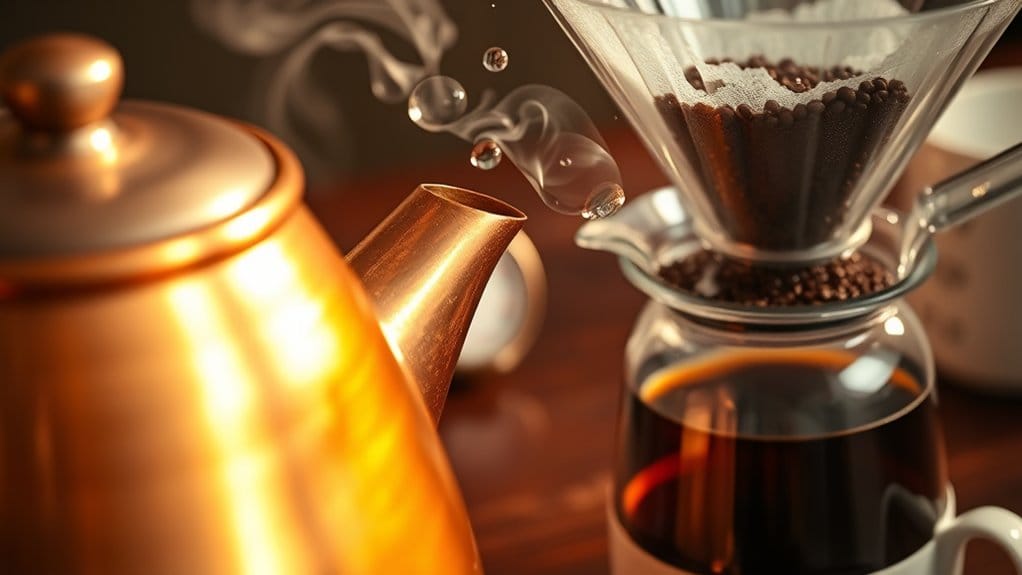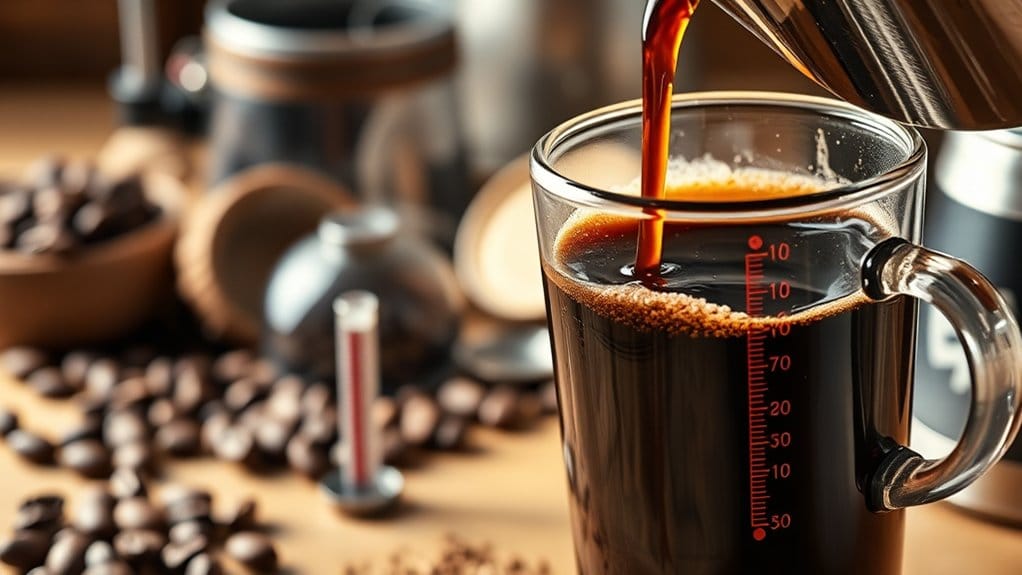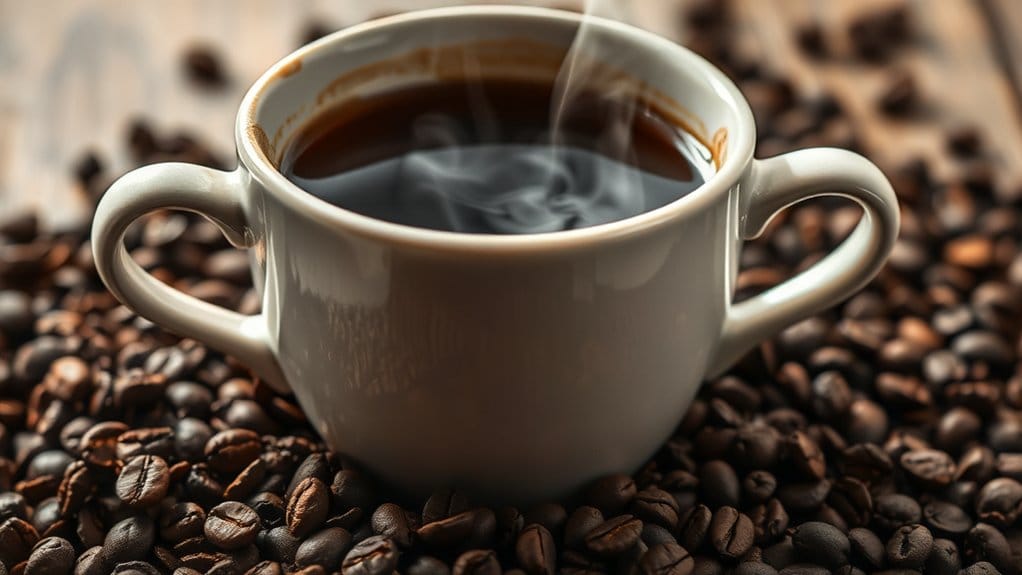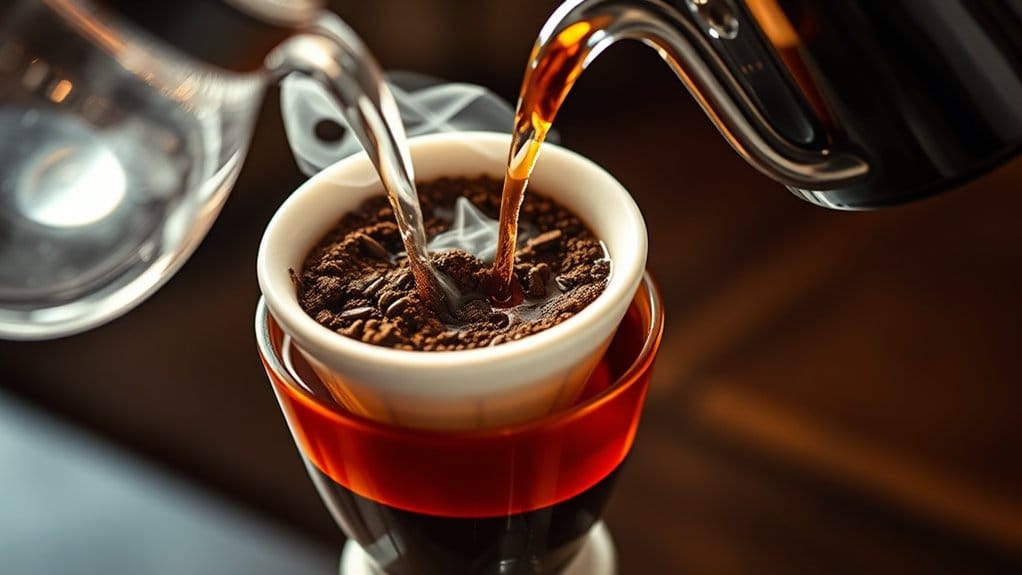Physical Address
304 North Cardinal St.
Dorchester Center, MA 02124
Physical Address
304 North Cardinal St.
Dorchester Center, MA 02124

Water temperature plays an essential role when brewing coffee. If it’s too low, your cup might end up weak and watery, like a sad, lonely puddle. On the flip side, too much heat can release bitterness, hiding those lovely floral notes you crave. Aim for a sweet spot around 200°F for the best flavors. Excited to learn how to achieve that perfect balance and reveal the rich taste you deserve? Hang tight, there’s more to uncover!

When brewing coffee, the right water temperature really matters, and it can make all the difference in your cup.
Aim for that sweet spot between 195°F and 205°F. Going too low? You’ll end up with weak, watery coffee. Too high? You risk bitter notes overtaking the flavor. Aiming for about 200°F is your best bet. Optimal brewing temperature ensures a balanced extraction that brings out the best flavors in your coffee. Remember, water temperature affects the rate of extraction, so keeping it within this range is crucial for achieving the perfect balance of sweetness and bitterness.
Though you might think a stronger brew equals a better cup of coffee, over-extraction can turn your morning routine into a bitter disappointment.
When you brew at too high a temperature, you pull out harsh, bitter flavors. You lose those lovely floral or fruity notes, drowning them in a barrage of harshness. Espresso brewing may require precise temperature control to prevent this from happening.
Plus, your coffee can feel dry and astringent, not the smooth sip you’re after. Imagine wanting a comforting hug from your cup and getting a slap instead!
By letting the water get too hot, you strip away the rich complexity and richness we crave. Higher temperatures can inadvertently increase extraction of soluble elements, leading to a less enjoyable experience. Keep an eye on water temperatures and remember, balance is key in creating the perfect cup.
After all, isn’t life too short for bad coffee?

Under-extracted coffee can leave you feeling a bit let down, like a good book that suddenly ends without a satisfying resolution. Instead of that rich, delightful brew, you’re met with sharp, sour notes that scream “too acidic!”
It’s like tasting lemon juice without the sugar. You’ll notice a watery body that lacks that comforting depth you crave, leaving your palate underwhelmed. The acidity shines bright and harsh, but sweetness is nowhere to be found. This imbalance can make every sip feel incomplete, with green or vegetal flavors sneaking in, too. Poor brewing practices, like using low water temperatures or a coarse grind, can lead to this disappointing cup; adjusting the coffee-to-water ratio can significantly enhance flavor extraction.
You might be wondering, “What went wrong?” Poor brewing practices, like using low water temperatures or a coarse grind, often lead to this disappointing cup. Adjusting those variables can turn your brew around! Balanced extraction is key to drawing out those desired flavors for a harmonious cup.
Adjusting for altitude in brewing coffee might seem tricky, but it can make a world of difference in your morning cup.
At higher elevations, water boils at lower temperatures, which limits your brewing options. If you’re at 5,000 feet, your water’s only reaching about 202°F instead of the usual 212°F. This can leave you with weak coffee that tastes like disappointment.
To avoid this, try using a finer grind or brewing methods that increase pressure, like espresso. You might even want a fancy brewer that adjusts for altitude automatically. Proper filtration systems ensure optimal water chemistry, helping to enhance your coffee experience further.
Just remember, tweaking these variables can improve flavor and balance, turning your cup into a delightful brew, rather than a sad mug of regret. Who wants that, right?

Mastering the art of coffee brewing is like tuning a musical instrument; getting the temperature just right can turn a simple cup into a harmony of flavors.
Aim for that sweet spot of 195°F to 205°F when brewing, whether you’re using a pour-over, French press, or drip coffee maker. If it’s too hot, watch out for bitterness; too cool, and your coffee turns weak and sour.
Use thermometers or electric kettles to keep track of your temperatures, and adjust based on your bean roast. Lighter roasts love a bit of heat, whereas darker ones can handle cooler waters. Additionally, grind size influences the extraction balance, making it essential to master both temperature and grind for an optimal coffee experience.
Yes, the type of coffee bean influences brewing temperature preferences. For instance, Arabica beans thrive at higher temperatures, whereas Robusta beans fare better at lower ones. Adjust your temperature to suit the bean for best flavor extraction.
You should heat water for about 2-5 minutes, depending on your method. If boiling, let it cool for 30-60 seconds. This way, you guarantee the temperature hits that ideal extraction range.
Yes, you can use a thermometer to measure coffee brewing temperature. It’s a reliable way to guarantee your water’s at the right temperature, helping you achieve consistent flavor and quality in your coffee brews.
To maintain ideal brewing temperature, you can use PID controllers, electric kettles with temperature hold functions, thermal insulation sleeves, and heat wraps. These tools help regulate heat effectively throughout your coffee brewing process.
Your brewing method greatly impacts ideal water temperature. For instance, espresso needs higher temps for bold flavors, whereas French press benefits from slightly cooler water, ensuring balanced extraction and preventing bitterness or sourness in your cup.